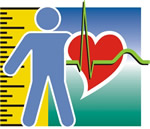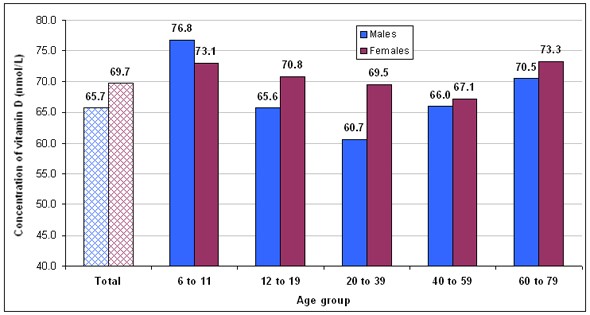Vitamin D status of Canadians 2007 to 2009
Archived Content
Information identified as archived is provided for reference, research or recordkeeping purposes. It is not subject to the Government of Canada Web Standards and has not been altered or updated since it was archived. Please "contact us" to request a format other than those available.

Vitamin D is best known for its role in bone health, as it helps the body absorb calcium. However, recent studies suggest that older people with lower blood levels of vitamin D are more likely to lose their balance and fall, possibly because of vitamin D's role in promoting muscle function. Lower levels of vitamin D have been associated with a greater risk of fractures, falls, breast and colorectal cancers, poor immunity and cardiovascular and other diseases such as multiple sclerosis.
When vitamin D deficiency occurs, very little calcium is absorbed. Deficiency in children can cause nutritional rickets, a condition that results in soft bones and skeletal deformities. In adults, low levels of vitamin D can cause osteoporosis, which decreases bone mass and bone tissue and increases the risk of fractures.
Vitamin D comes from foods and supplements, and from sun exposure. Because vitamin D is found naturally in only a few foods like fatty fish and egg yolks, it is added to foods such as milk and margarine.
Unlike other nutrients, a substantial amount of vitamin D can actually be made by the body when the skin is exposed to sunlight. During the spring and summer in Canada, normal daily sun exposure produces sufficient vitamin D, but vitamin D production is unlikely to occur from late October through early March. Also, it is more difficult for people with darker skin to get adequate vitamin D through sun exposure, because the melanin in darker skin decreases vitamin D production. As well, the skin's ability to produce vitamin D drops with age, putting people older than 50 at risk.
Vitamin D is measured in nanomoles per litre (nmol/L). Levels below 27.5 nmol/L denote deficiency. Levels below 37.5 nmol/L are considered inadequate for bone health. And it has recently been suggested that 75 nmol/L is optimal for overall health.
Results
In 2007 to 2009, the average level of vitamin D for Canadians aged 6 to 79 was 67.7 nmol/L. For both sexes, levels of vitamin D followed a U-shape by age group: highest among children and seniors, and lowest at ages 20 to 39. Levels tended to be higher among teenage girls and women than in teenage boys and men.
Chart 1
Average vitamin D levels by age group and sex

Source: Canadian Health Measures Survey, 2007 to 2009
Almost 90% of Canadians had vitamin D levels adequate for bone health (at least 37.5 nmol/L). Women were more likely than men to have adequate concentrations. As well, 35% of the population had levels above 75 nmol/L. The percentage with at least 75 nmol/L was highest among children aged 6 to 11 (49%) and seniors aged 60 to 79 (45%); it was lowest at ages 20 to 39 (30%).
An estimated 4% of the population (5% of men and 3% of women) had levels below 27.5 nmol/L, indicating vitamin D deficiency. The highest prevalence of deficiency—7%― was among men aged 20 to 39.
Frequent milk consumption was related to vitamin D levels in people of all ages. Those who consumed milk more than once a day averaged 75 nmol/L, compared with 63 nmol/L among those who consumed milk less than once a day.
White racial background was associated with higher levels of vitamin D. The average difference between people whose racial background was White and people of other backgrounds was approximately 19 nmol/L.
More information on this topic is available in "Vitamin D status of Canadians as measured in the 2007 to 2009, Canadian Health Measures Survey" Health Reports, Vol. 21, number 1.
- Date modified:
